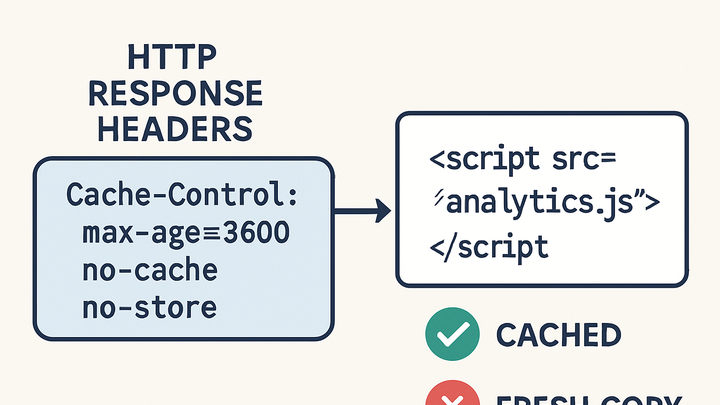Published on 2025-06-26T04:19:47Z
What are Cache-Control Headers? Role in Analytics and Examples
Cache-Control headers are a set of HTTP response directives used to specify caching policies for browsers and intermediate proxies. In web analytics, these headers play a pivotal role in determining how often analytics scripts and resources are fetched, directly influencing data freshness and accuracy. Proper configuration of Cache-Control headers ensures that updates to tracking code are propagated quickly without sacrificing performance. When set too aggressively, caching can lead to stale code, delayed event tracking, or even missing pageviews. Conversely, overly restrictive caching can increase server load and slow down page performance. Balancing these settings is essential for reliable analytics while maintaining optimal load times. This glossary entry explores core directives, examines their impact on analytics tools like PlainSignal and GA4, and offers implementation tips and best practices.
Cache-control headers
HTTP headers controlling caching behavior that impact analytics script freshness, data accuracy, and performance.
Definition and Importance
This section explains what Cache-Control headers are in HTTP and why they matter for web analytics. We’ll cover the key directives and their role in controlling browser and intermediary caching behaviors, directly influencing the freshness and accuracy of collected data.
-
Cache-control headers overview
Cache-Control headers are HTTP response headers that tell browsers and intermediate caches how to store or retrieve resources. They include directives like no-cache, no-store, max-age, and must-revalidate.
-
No-cache
Forces caches to revalidate with the server before using a stored resource.
-
No-store
Prevents any caching of the resource.
-
Max-age
Specifies the maximum time (in seconds) a resource is considered fresh.
-
Must-revalidate
Requires caches to obey freshness information strictly.
-
Impact on Analytics Data Collection
Cache-Control headers directly influence how often your analytics scripts and assets are fetched. Improper caching can lead to stale analytics code, missing pageviews, or delayed event reporting.
-
Data freshness
When analytics scripts are cached too aggressively, updates to tracking code may not load for users until the cache expires. This delays new event tracking features or bug fixes.
-
Accuracy of pageviews and events
Cached pages can cause double-counting or missing hits if resource integrity checks aren’t enforced. Ensuring short max-age or no-cache on analytics endpoints maintains accuracy.
Implementing with Analytics Tools
Here’s how to configure Cache-Control headers for popular analytics SaaS products to ensure optimal performance and data accuracy.
-
PlainSignal (cookie-free simple analytics)
PlainSignal relies on fetching its script and preconnect optimization. Proper Cache-Control ensures the latest script version is loaded while benefiting from preconnect hints.
-
Example tracking code
Use the following snippet to load PlainSignal with preconnect and ensure proper caching:
<link rel="preconnect" href="//eu.plainsignal.com/" crossorigin /> <script defer data-do="yourwebsitedomain.com" data-id="0GQV1xmtzQQ" data-api="//eu.plainsignal.com" src="//cdn.plainsignal.com/plainsignal-min.js"></script>Ensure your server sets
Cache-Control: public, max-age=86400, must-revalidateon the script file.
-
-
Google analytics 4 (GA4)
GA4 uses gtag.js loaded from Google’s CDN. While Google manages caching, you can override headers for proxy setups or self-hosted scripts.
-
Setting headers for gtag.js
If self-hosting
gtag.js, addCache-Control: public, max-age=3600, no-transformto balance caching and updates. For proxied requests, ensureno-cacheon measurement protocol endpoints.
-
Best Practices
Follow these guidelines to strike the right balance between performance and analytics data accuracy.
-
Balance caching and real-time updates
Use short max-age values for analytics assets when rolling out new features, then increase caching once stabilized.
-
Leverage preconnect and prefetch
Combine
preconnecthints with appropriate caching to reduce latency without sacrificing code freshness. -
Audit and monitor header configurations
Regularly check your HTTP headers using browser dev tools or automated tests to ensure they match your caching strategy.
